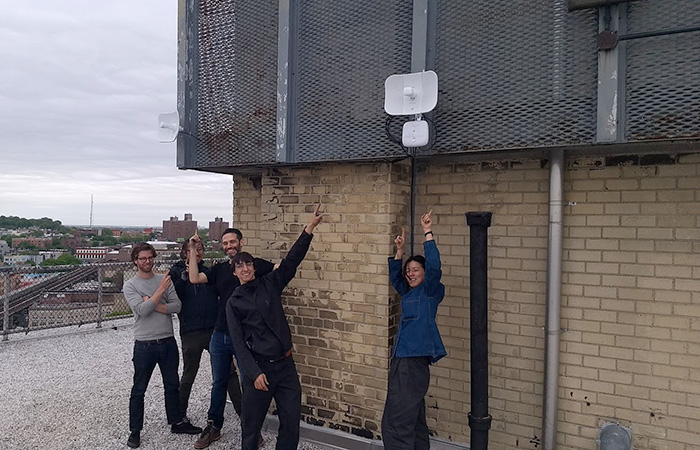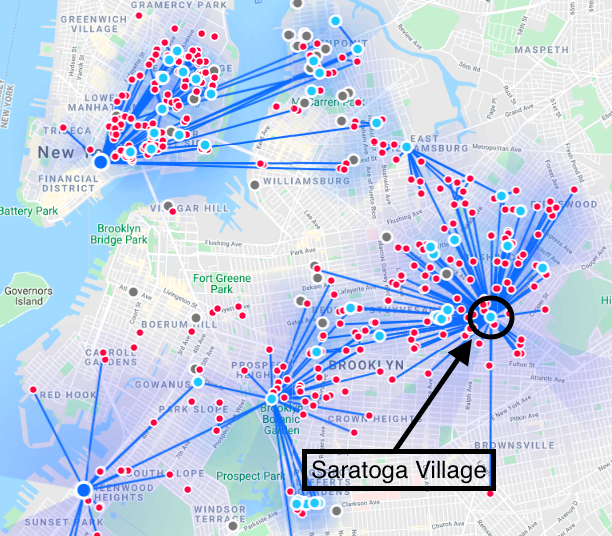Building Grassroots Environmental Infrastructure (and bridging the digital divide)
By: Scott Rasmussen
February 21, 2020
In May of 2018, a crew of eager volunteers set to work running ethernet cable and fixing antennae to the roof of Saratoga Village, a 16-story public housing development in Brooklyn. These volunteers were united in this unique mission as members of the non-profit NYC Mesh, a community network dedicated to ensuring that all New Yorkers — no matter what they can afford or where they may live — can connect online. In the course of a week, the volunteers installed community infrastructure that would improve building efficiency and monitor air quality as well as provide a free, high-speed internet connection to residents. Strategically-placed equipment on the roof allowed those living in surrounding buildings to connect online with nothing more than a small rooftop antenna and a suggested monthly donation.

The genesis of the Saratoga Village "install" — as such an endeavor is called in the NYC Mesh community — began with a short email from BlocPower, a Brooklyn-based startup using remote sensing technology to improve heating and cooling efficiency in buildings. BlocPower, had recently entered into a partnership with the New York City Housing Authority (NYCHA) to pilot smart building technology in public housing. Many of the gadgets and gizmos planned for this undertaking, however, required low-cost or no-cost connectivity. Paying a cellular data plan for each of the dozens of devices was simply out of the question.
Enter NYC Mesh.
Within weeks, BlocPower and NYC Mesh entered a partnership promising not only to lay a digital foundation for smart building technology in aging public housing, but also to connect residents online and build community infrastructure serving the surrounding neighborhoods. In other words, a win-win-win.
Specifically, with the connectivity supplied by NYC Mesh, BlocPower installed 28 low-power sensors throughout the building that supplied integrated data on utility usage, heating and hot water systems, and the indoor environment. This allowed NYCHA to optimize systems and ultimately reduce energy use and costs. Additionally, the sensors provided predictive maintenance and diagnostics such that NYCHA staff could act before problems arose. Finally, in the course of the pilot, the sensors were also used to detect whether volatile compounds were present in the buildings air systems, ensuring the safety of residents.
While in the case of BlocPower, devices primarily optimized building efficiency, there are plenty of applications for this remote sensing technology, from collecting noise pollution and air quality data to monitoring rooftop solar installations.
The aim here, however, is not to give a shout-out for any particular future smart city or smart building "revolution" — there are countless marketing departments pumping out literature for that. Rather, the example of NYC Mesh and its committed volunteers at Saratoga Village demonstrate how grassroots (and perhaps not so grassroots) initiatives to promote digital equity and access can work hand-in-hand with environmental initiatives.
First, a little about NYC Mesh: Founded in 2014, the entirely volunteer-run organization is part of a growing, international community networking movement committed to improving digital access and creating a new internet infrastructure that puts people and communities first. It's built on the premise, as early internet activist Vint Cerf once noted, that "the internet is for everyone — but it won't be unless we make it so."
NYC Mesh operates with much of the same WiFi technology that you may have at home — a small router or antenna wirelessly communicating with a series of devices such as a laptop or cell phone. In the case of NYC Mesh, these small antennae ("nodes") are located on rooftops across the city where they connect apartment dwellers online through hardwired home routers and broadcast open WiFi networks for use by pedestrians or others passing by. (You can find the entirely open — NYC Mesh Community WiFi — network along streets across Brooklyn and Lower Manhattan.) These rooftop nodes interconnect to form a wireless "mesh" across the city. Internet traffic at each node hops from antenna to antenna back to an "internet exchange point," a fancy term for a location where various networks, say Google, Netflix, and NYC Mesh, all connect together — forming, to put it very simply, the internet.

Community networks offer more than a grassroots means to combat the digital divide — an effort that itself is sorely needed in a city like New York where 1.5 million residents lack a home or mobile connection online. They also construct a community-owned and, ultimately, community-accountable digital layer in neighborhoods that can advance 21st-century environmental solutions and justice. When communities own their connectivity and the underlying infrastructure, they are empowered to support the development of local green businesses like BlocPower; they have the means to collect environmental data to inform stakeholders, policy, or even hold landlords accountable; and they can improve transparency and access to information.
The New York City Mayor's Office recently embarked on an effort to measure air quality in the South Bronx, an area with well above average levels of fine particulate matter outdoors. The pilot will attach sensors to city vehicles to generate precise, street-level data. With community networks, neighborhood organizations, building owners, activists, and others can exercise self-determination and take on these initiatives themselves — no more waiting on city leadership, better budget forecasts, or a sympathetic internet service provider.
NYC Mesh and likeminded networks in urban landscapes and rural communities are already deploying infrastructure on rooftops (or whatever may be available) across the globe. With relative ease, these resources could be leveraged to weave together economic development, community self-determination, resiliency, and environmental justice and stewardship. This is a field ripe for collaboration and — at NYC Mesh at least — we are already getting to work.
WhoIs:
Scott Rasmussen focuses on telecommunications policy and strategy at the intersection of equity and access. Scott is currently a Board Member and organizer for NYC Mesh, an open, neutral, and resilient community network aiming to make a home or business internet connection accessible and affordable to all New Yorkers. NYC Mesh is the largest community network in North America. Scott arrived at NYC Mesh with five years of experience developing policy and legislation on Capitol Hill, where he specialized in telecommunications. In his current position, Scott supports telecommunications planning and deployment in New York State. Scott can be found online at @rscooter369

